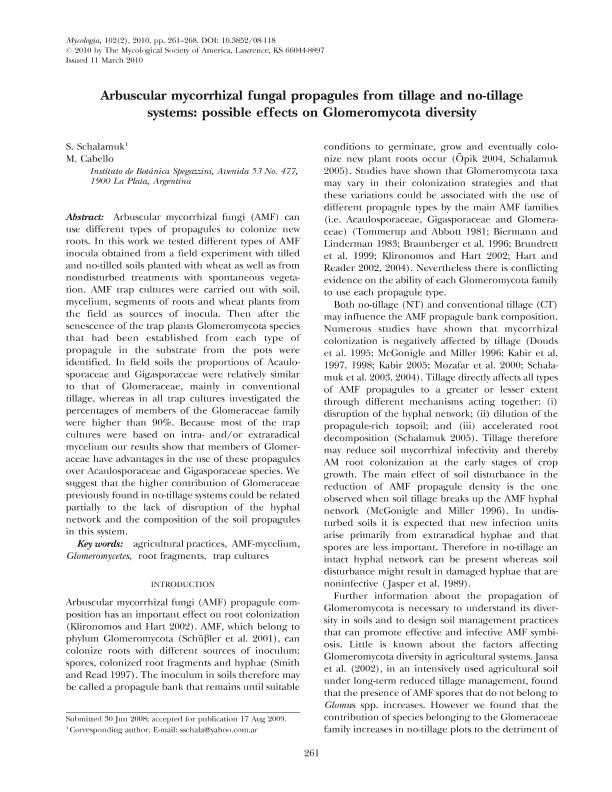Mostrar el registro sencillo del ítem
dc.contributor.author
Schalamuk, Santiago

dc.contributor.author
Cabello, M.
dc.date.available
2020-12-11T17:11:27Z
dc.date.issued
2010-03
dc.identifier.citation
Schalamuk, Santiago; Cabello, M.; Arbuscular mycorrhizal fungal propagules from tillage and no-tillage systems: Possible effects on Glomeromycota diversity; Allen Press Inc.; Mycologia; 102; 2; 3-2010; 261-268
dc.identifier.issn
0027-5514
dc.identifier.uri
http://hdl.handle.net/11336/120243
dc.description.abstract
Arbuscular mycorrhizal fungi (AMF) can use different types of propagules to colonize new roots. In this work we tested different types of AMF inocula obtained from a field experiment with tilled and no-tilled soils planted with wheat as well as from nondisturbed treatments with spontaneous vegetation. AMF trap cultures were carried out with soil, mycelium, segments of roots and wheat plants from the field as sources of inocula. Then after the senescence of the trap plants Glomeromycota species that had been established from each type of propagule in the substrate from the pots were identified. In field soils the proportions of Acaulosporaceae and Gigasporaceae were relatively similar to that of Glomeraceae, mainly in conventional tillage, whereas in all trap cultures investigated the percentages of members of the Glomeraceae family were higher than 90%. Because most of the trap cultures were based on intra-and/or extraradical mycelium our results show that members of Glomeraceae have advantages in the use of these propagules over Acaulosporaceae and Gigasporaceae species. We suggest that the higher contribution of Glomeraceae previously found in no-tillage systems could be related partially to the lack of disruption of the hyphal network and the composition of the soil propagules in this system.
dc.format
application/pdf
dc.language.iso
eng
dc.publisher
Allen Press Inc.

dc.rights
info:eu-repo/semantics/openAccess
dc.rights.uri
https://creativecommons.org/licenses/by-nc-sa/2.5/ar/
dc.subject
AGRICULTURAL PRACTICES
dc.subject
AMF-MYCELIUM
dc.subject
GLOMEROMYCETES
dc.subject
ROOT FRAGMENTS
dc.subject
TRAP CULTURES
dc.subject.classification
Biología Celular, Microbiología

dc.subject.classification
Ciencias Biológicas

dc.subject.classification
CIENCIAS NATURALES Y EXACTAS

dc.title
Arbuscular mycorrhizal fungal propagules from tillage and no-tillage systems: Possible effects on Glomeromycota diversity
dc.type
info:eu-repo/semantics/article
dc.type
info:ar-repo/semantics/artículo
dc.type
info:eu-repo/semantics/publishedVersion
dc.date.updated
2020-12-04T18:42:54Z
dc.journal.volume
102
dc.journal.number
2
dc.journal.pagination
261-268
dc.journal.pais
Estados Unidos

dc.journal.ciudad
Lawrence
dc.description.fil
Fil: Schalamuk, Santiago. Universidad Nacional de La Plata. Facultad de Ciencias Naturales y Museo. Instituto de Botánica Spegazzini; Argentina. Consejo Nacional de Investigaciones Científicas y Técnicas. Centro Científico Tecnológico Conicet - La Plata; Argentina
dc.description.fil
Fil: Cabello, M.. Universidad Nacional de La Plata. Facultad de Ciencias Naturales y Museo. Instituto de Botánica Spegazzini; Argentina
dc.journal.title
Mycologia

dc.relation.alternativeid
info:eu-repo/semantics/altIdentifier/doi/https://doi.org/10.3852/08-118
dc.relation.alternativeid
info:eu-repo/semantics/altIdentifier/url/https://www.tandfonline.com/doi/abs/10.3852/08-118?journalCode=umyc20
Archivos asociados
